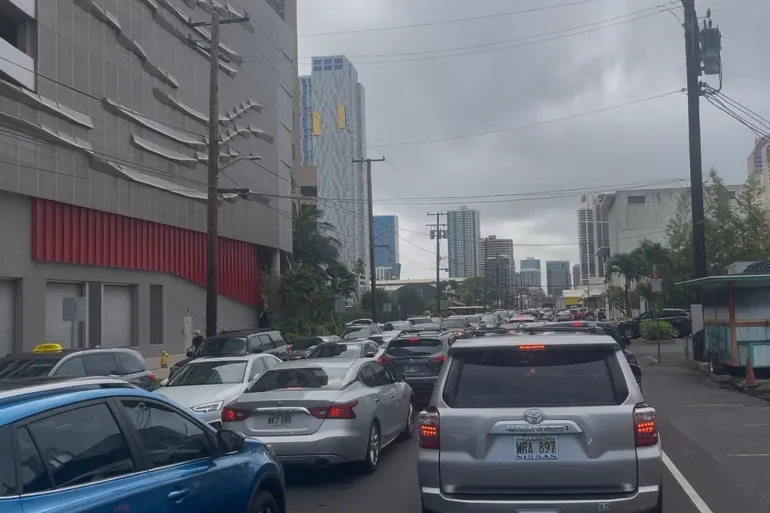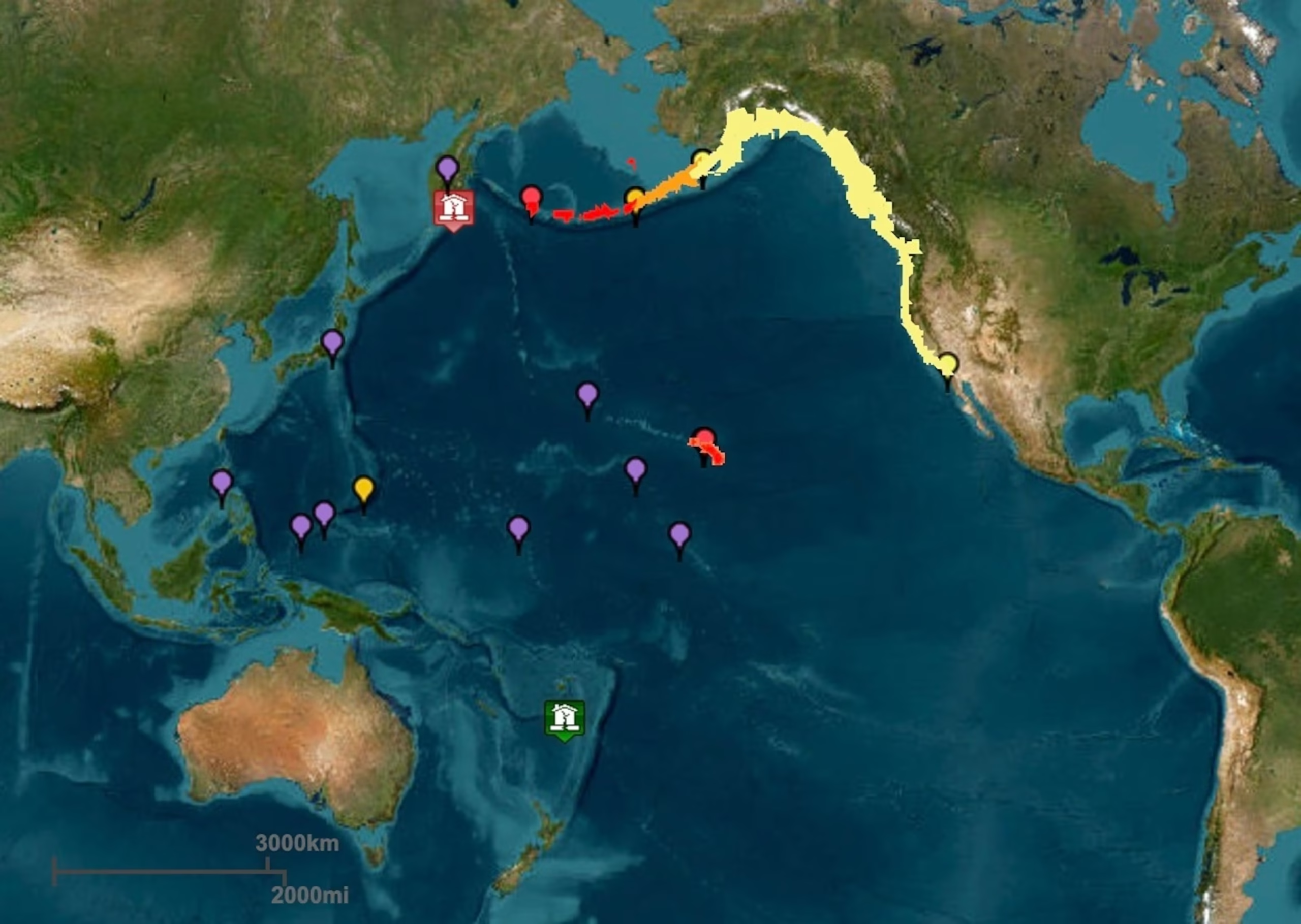Tsunami waves in Hawaii and California… how other US coastal cities should prepare

Panic on the Pacific: Tsunami Waves Reach U.S. Coast After Powerful Quake Near Russia. Photo credit: AP
Tsunami waves have reached the shores of California and Hawaii following a powerful 8.8-magnitude earthquake that rocked Russia’s far-eastern Kamchatka Peninsula, triggering widespread tsunami alerts across the Pacific.
According to the U.S. National Weather Service, the first tsunami waves breached the U.S. mainland at San Francisco’s coast around 1:12 a.m. local time (08:12 GMT) on Wednesday. Arena Cove and other parts of California’s coastline also reported impacts, with waves continuing to move southward.
The National Weather Service has maintained a tsunami warning—the highest threat level—for areas spanning from Cape Mendocino up to the Oregon-California border. A tsunami advisory, indicating a lower-level threat, remains in effect for regions stretching from the California-Mexico border to Cape Mendocino, including the San Francisco Bay Area.
Meanwhile, Hawaii experienced tsunami waves measuring between 1 and 1.2 meters (3.3 to 3.9 feet), which began hitting the islands shortly after 8 p.m. local time Tuesday (06:00 GMT Wednesday), as confirmed by the Pacific Tsunami Warning Center. Although a warning was initially issued, it was later downgraded to an advisory after authorities assessed the likelihood of a major tsunami to be low.
READ ALSO
Hawaii alert: What is Tsunami and how is it detected? — here’s all to know
Tsunami Warning in Hawaii: What residents should do
“Hawaii recorded a tsunami surge of at least a meter but appears to have avoided a major disaster,” reported Al Jazeera’s correspondent Rob McBride from Kuala Lumpur.
In response, Hawaii’s Governor Josh Green confirmed that flights in and out of Maui, the state’s second-largest island, were cancelled Tuesday night. Honolulu, the capital city, also experienced gridlock as residents scrambled to respond to early warnings.
Further up the Pacific coast, tsunami advisories were extended to parts of Oregon, Washington, and Alaska. Coastal monitoring stations detected waves along the Aleutian Islands and the Pacific-facing areas of the Alaska Peninsula. The National Tsunami Warning Center in Alaska warned that wave activity could continue for several hours or even longer.
“Tsunamis send massive ripples across the ocean. These waves can rebound, moving back and forth across coastlines for extended periods,” explained Dave Snider, the Center’s tsunami warning coordinator.
The origin of this Pacific-wide tsunami threat lies in one of the largest recorded earthquakes in Russia’s modern history. The quake, centered near Kamchatka, generated waves as high as 4 meters (13 feet), submerging buildings and prompting mass evacuations on nearby islands.
Though Russian authorities initially issued tsunami alerts, they later confirmed there were no casualties and lifted warnings for their Far East territories. Similarly, Japan, which braced for potential devastation due to its proximity to the epicenter, has also downgraded all tsunami-related warnings.
As the Pacific basin gradually recovers from the seismic shock, authorities across affected regions remain on high alert, urging coastal residents to stay informed and adhere to safety advisories.
How Other US Coastal Cities Should Prepare
The recent tsunami is a wake-up call for all coastal U.S. cities—not just California and Hawaii. Here’s how these cities should step up preparation:
1. Develop and Upgrade Early Warning Systems
Coastal cities must invest in real-time seismic sensors and tsunami detection buoys that feed directly into emergency response centers. The Pacific Tsunami Warning Center and the U.S. Tsunami Warning System already provide excellent services, but their integration with local community alert systems needs to improve.
Text alerts, sirens, social media warnings, and highway signage must be consistent, timely, and accessible in multiple languages.
2. Create and Maintain Clear Evacuation Routes
Many U.S. cities, including Seattle, San Diego, and Charleston, have detailed tsunami evacuation maps—but not all residents are aware of them. These cities should:
-
Regularly inspect and update evacuation route signage.
-
Conduct city-wide tsunami drills at least once a year.
-
Ensure that people with disabilities, the elderly, and tourists can safely evacuate.
3. Educate the Public
Tsunami awareness should begin in schools and continue in communities. Knowing the natural signs of a tsunami (e.g., sudden retreat of the ocean or prolonged shaking) is critical. Public service campaigns can be disseminated via local radio, TV, and online platforms.
Educational materials should also address the “second wave” phenomenon, where a larger wave often follows an initial smaller one—tricking some people into returning too soon.
4. Invest in Infrastructure Resilience
Sea walls, elevated roads, and sturdy emergency shelters can save lives. Cities like Long Beach (CA) and Crescent City (CA), both highly exposed to tsunami threats, have made infrastructure improvements. These efforts should be replicated and scaled in other coastal zones.
Critical facilities like hospitals and power plants should also be moved inland or protected by elevated platforms and reinforced barriers.
5. Learn from Global Best Practices
Japan and Chile, both regularly hit by tsunamis, offer valuable lessons in mitigation. Japan’s multilevel tsunami warning system, vertical evacuation towers, and rapid-response emergency teams have saved thousands of lives in subsequent events since 2011.
U.S. cities should consider partnerships or technical collaborations to adopt similar innovations.
Climate Change and Sea Level Rise: Worsening the Threat
Rising sea levels due to climate change mean that even smaller tsunami waves could now inundate further inland. Coastal erosion, saltwater intrusion, and higher storm surges amplify tsunami risks. U.S. cities must integrate tsunami preparedness into their climate adaptation strategies.
Federal and State Support: The Way Forward
The Federal Emergency Management Agency (FEMA), National Oceanic and Atmospheric Administration (NOAA), and the U.S. Geological Survey all play critical roles in funding, coordinating, and supporting tsunami preparedness.
Cities should actively seek federal grants to build infrastructure and participate in the National Tsunami Hazard Mitigation Program. Coordination between state and local governments is vital to streamline responses and avoid confusion during emergencies.
The recent tsunami waves striking the U.S. coast from a distant earthquake in Russia are a sharp reminder that no coastal region is immune. As the Pacific tectonic plates shift, the risk of deadly tsunamis remains ever-present. It’s not a question of if but when the next major tsunami will test America’s readiness.
Preparedness, awareness, and investment must now become permanent priorities—not just temporary reactions to near-misses.



